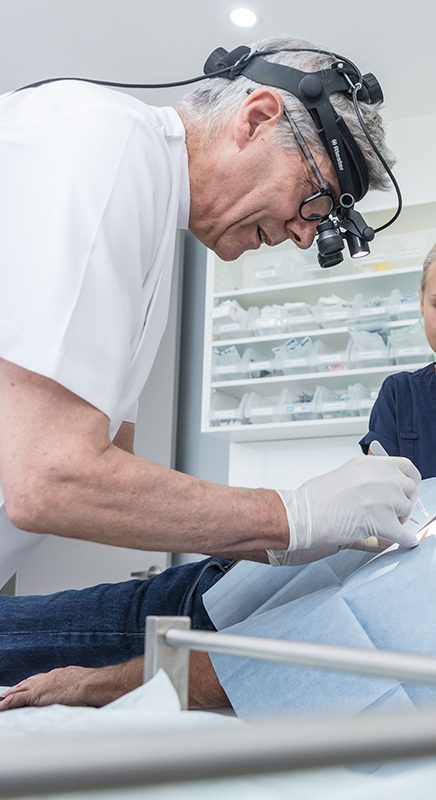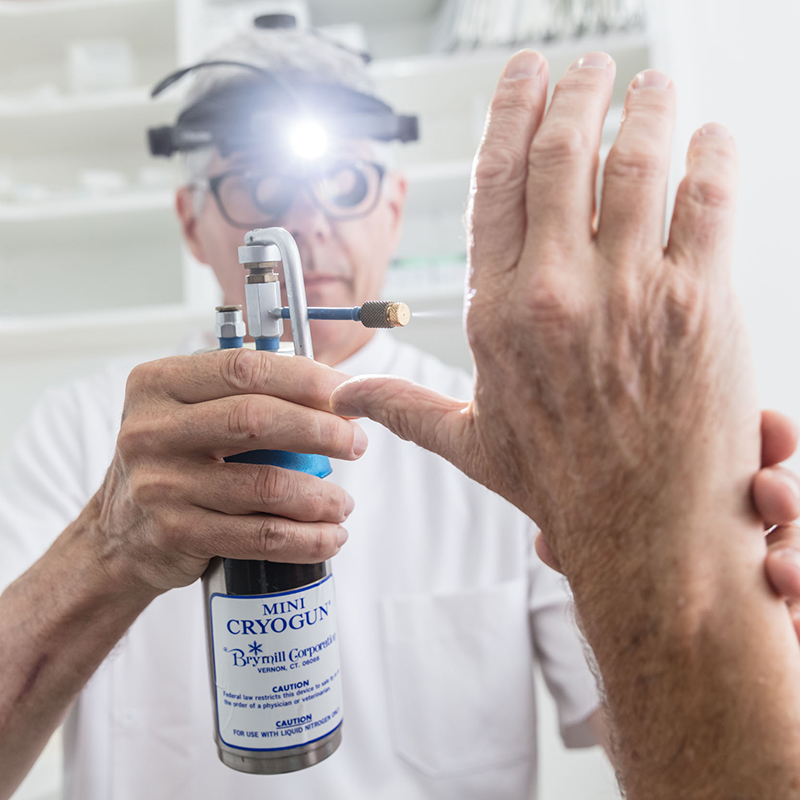Skin Cancer Clinic
At the North Sydney General Practice Skin Cancer Clinic, our focus is on prevention and early detection and treatment of skin cancers and precancerous lesions like solar keratosis.
We are dedicated to the best possible cosmetic result from the treatment of skin cancer. Our aim is to provide the best possible skin cancer service and to make the time available to do this.
Skin Cancer Checks using dermoscopy are the gold standard for detecting skin cancers with a focus particularly on early melanoma, which is much safer treated at an early stage. Non Melanoma Skin Cancer (BCC and SCC) are also much simpler to treat when found at an early stage. A skin check involves a survey of skin over the whole body with underclothes on. Lymph nodes are also checked in the neck, armpits and groin since they are where a skin cancer may spread to. You can of course have as much or as little of the skin checked as you like. Skin cancer is most common on sun exposed sites, but melanoma can occur in some unexpecteed sites such as the bottom of the feet and the nails.

Field Therapy is the use of cream or gel to treat solar keratoses over an area of skin, usually the face or the backs of the hands. There are several different medications used for field therapy and they each have their pros and cons. See below for more information.
Biopsy is the taking of a sample of skin for analysis by the pathologist to obtain a diagnosis. This will often involve use of a fine suture which will be removed after a week.
Excision is the cutting out of a lesion. Our policy is to do this only when necessary, with the least possible pain and inconvenience and the best possible cosmetic outcome. Sometimes you might prefer a plastic surgeon to do this. We may refer you to a specialist for some excisions.
Complex excisions involve a flap (moving adjacent skin) or graft (taking skin from another site) to close a wound. This is sometimes necessary to close wounds on the lower legs, larger wounds or some challenging sites.
Digital photography is used to record every lesion biopsied or excised. This is an important part of managing skin cancer. These photographs are securely stored on our system and backed up encrypted on a physical device and the cloud.
Total Body Photography is an option for monitoring the skin for new or changing lesions. Oracle Health in Westbourne Avenue St Leonards does this quickly and efficiently.

Dr Graham Chaffey is a Skin Cancer Doctor accredited by the Skin Cancer College of Australia and New Zealand; a GP at Hazelbrook in the Blue Mountains since 1993, specialising in Skin Cancer Medicine and Surgery since 2013.
Skin Cancer Clinic Fees
Skin Cancer Check/ Consultation:
$120 for a standard skin check (rebate of $42.85); $160 for a long skin check (rebate of 82.90) ie out of pocket expense $77.00
Cryotherapy:
$20
Biopsy:
$55
Excision:
$150
Complex Excision (flap or graft):
$210
FIELD THERAPY for SOLAR KERATOSES
Field Therapy is treatment of an area of skin in order to eliminate Solar Keratoses.
There is a choice of 5 different compounds applied to the surface of the skin that work by different mechanisms.
No field therapy is covered by the PBS. They are all private prescriptions.
| Time to complete application | Cost | |
Efudix | 3 weeks on average | $48 | |
Aldara | 28 days sometimes repeated | $55 | |
Solaraze | 3 months | $50 | |
Daylight PDT | 3 hours | $230 | Back to normal after about 5 days |
5-FUC | 7 days | $100 | Scalp, forearms and hands. Not face. |
The compounds are all similarly effective. The application of Picato and Daylight PDT is completed before the maximum effects appear. With the slower acting compounds you can “titrate” the application until the appropriate response is achieved. But there’s the trade-off of having the inflammation for much longer. The effects of Daylight PDT are very predictable however, so this is not a practical issue with it.
All the treatments cause inflammation of normal cells but kill the abnormal cells of solar keratosis whose abnormal cell walls allow chemicals to get in 10 times more.
Efudix is best used in winter because sunlight increases the reaction without increasing the benefit.
Aldara may rarely cause a flare of an autoimmune disease (but there is no evidence that it can initiate an autoimmune disease).
It is a good idea to return for review after completion of the treatment.
EFUDIX
Efudix (5-fluorouracil) throws a spanner in the works of DNA because it is a mimic of one of the bases that make the DNA code. It is used as chemotherapy for some internal cancers.
The maximum area you can treat at once is 500 square cms. So you could treat both hands and forearms at once or your whole face. You may prefer to treat a smaller area though, because the area can get quite sore towards the end of treatment.
People react differently to Efudix. The plan is to use it for 1 to 4 weeks, twice a day, until there is sufficient reaction. The amount of redness indicates that the efudix has done its work.
Exposure to sunlight while using efudix causes more inflammation (without making it work better) so use sunscreen and a hat and avoid the sun during treatment, or even wait till winter.
Efudix may cause dermatitis which will be apparent as a more even redness over the whole area of application, not just redness of the solar keratoses.
Sometimes people experience fever, nausea, diarrhoea, headache or mouth ulcers. This is less likely if you treat a small area at one time.
Approximately 8% of people are thought to have partial dihydropyrimidine dehydrogenase deficiency and they get a stronger reaction to efudix. Severe reactions are extremely rare with skin administration but do occur.
Efudix should never be used during pregnancy as it can cause major malformations in the baby.
HOW TO APPLY IT:
Apply Efudix thinly to the site twice a day. Wash it off your fingers thoroughly afterwards.
Don’t wash the site of application for an hour. After that it matters much less if you wash or rub the ointment off.
Inflammation will increase and the lesions being targetted will begin to get “erosion”, which means they will ooze and get crusty, after 1 to 4 weeks. That is when Efudix has done its work and you can stop using it. Things heal up quickly after that.
ALDARA
Aldara stimulates the immune cells at the site, so causes inflammation. Some of these cells kill mutated skin cells and their activity is increased resulting in elimination of abnormal cells that the immune system was tolerating before.
Apply aldara by puncturing a sachet and using it as a squeeze tube. Keep the sachet in a closed jar so it doesn’t dry out. You can then get several days’ use out of one sachet. Apply aldara to the treatment area 3 days per week for 4 weeks. It may be necessary to change the frequency of application depending on the response. After application don’t wash the area for at least an hour. You can still use sunscreen and makeup on the treated area, just apply it after the aldara dries.
If the reaction becomes too painful or annoying, it is ok to stop aldara for a few days then start after the reaction has settled a bit. You don’t have to make up for these days by extending the 4 weeks.
Sometimes a second period of 4 weeks is required, after a break of 4 weeks.
Aldara can cause mild flu like symptoms, even diarrhoea and muscle pain. These symptoms may resolve with continued use, and will resolve after stopping the treatment. If you have an autoimmune disease, there is a possibility that aldara may trigger a flare up of that. There is no evidence that aldara can initiate an autoimmune disease.
Rarely aldara can cause an extreme response, with painful inflammation within a few days of commencement. If you are finding the response too much at any time, stop applying the aldara, photograph the reaction at its worst and see Dr Chaffey (or another doctor) as soon as possible.
Solaraze
Solaraze is Voltaren (diclofenac, an antiinflammatory) in a hyaluronic acid vehicle “which is designed to keep the drug in the epidermis and superficial dermis” rather than deeper absorption*.
Solar keratoses were found to have high levels of prostaglandins. Diclofenac blocks prostaglandin production, so it was tried for treatment of solar keratoses and found to be effective. We don’t know exactly how it works.
Solaraze is quite effective if used for 90 days. Only about 60% as effective if used for 60 days.
Itchy, dry skin is the only significant side effect. Inflammation is much milder than with Efudix or Aldara because Solaraze works more slowly. Whereas we aim for sufficient evidence of damage to the solar keratoses with Efudix and Aldara, with Solaraze we just aim for 90 days of treatment.
Solaraze shouldn’t be used in pregnancy (especially 3rd trimester when it can cause Patent Ductus Arteriosus) or while breastfeeding and may cause an allergic reaction in someone allergic to aspirin.
Daylight PDT (Daylight Photodynamic Therapy)
5-ALA is 5-aminolevulinic acid which is converted to protoporphyrin IX by enzymes inside cells. Certain wavelengths of visible light are absorbed by protoporphyrin IX delivering a quantum of energy that drives a chemical change producing reactive forms of oxygen that react with and destroy components of the cell. The outcome is selective destruction of the abnormal cells that make solar keratosis.
PDT using special lights has been used by dermatologists to treat a range of conditions in common practice since the 1980s. The principles of this therapy were discovered in 1902.
PDT using daylight for solar keratoses has been developed in the last decade. It has the advantage over conventional PDT of being much less painful. If it becomes painful the patient can withdraw from bright light which stops the reaction and the pain.
PDT has the advantage of involving the shortest period of inflammation.
For PDT under LED lighting, 13000 lux on the skin surface is required but you don’t need sunscreen or have to brave the elements.
5000 lux of sunlight is sufficient. Sitting in the car in the sun or near a large north facing window will achieve this. Glass blocks enough UV light to prevent sunburn during this time.
If the temperature where you are is 10 degrees Centigrade or lower, PDT doesn’t work.
What to Expect
The skin will become red and sore within 24 hours and gets to its worst redness and scaliness at about 48 hours. Most of the redness will resolve by 5 days. You will probably feel you can appear in public on about day 5. Sometimes there is more redness that may take up to 3 months to resolve completely.
How it is Applied
If you are going to sit outside, sunscreen will be applied as the first step.
Some thickened skin may need to be thinned by the doctor.
Off Label Indication
5-ALA is approved for PDT by the FDA in the USA as Levulan. In Australia and the UK however, it is methyl-aminolevulinic acid that is approved for PDT marketed as Metvix. The use of 5-ALA for daylight PDT is therefore an off-label use in Australia. We are required to have a signed consent form to acknowledge that you are aware it is an off-label use. If you would prefer, we can instead use Metvix for daylight PDT but it costs about $400.
The total cost to you is $169 for field therapy with 5-ALA.
5-FUC
